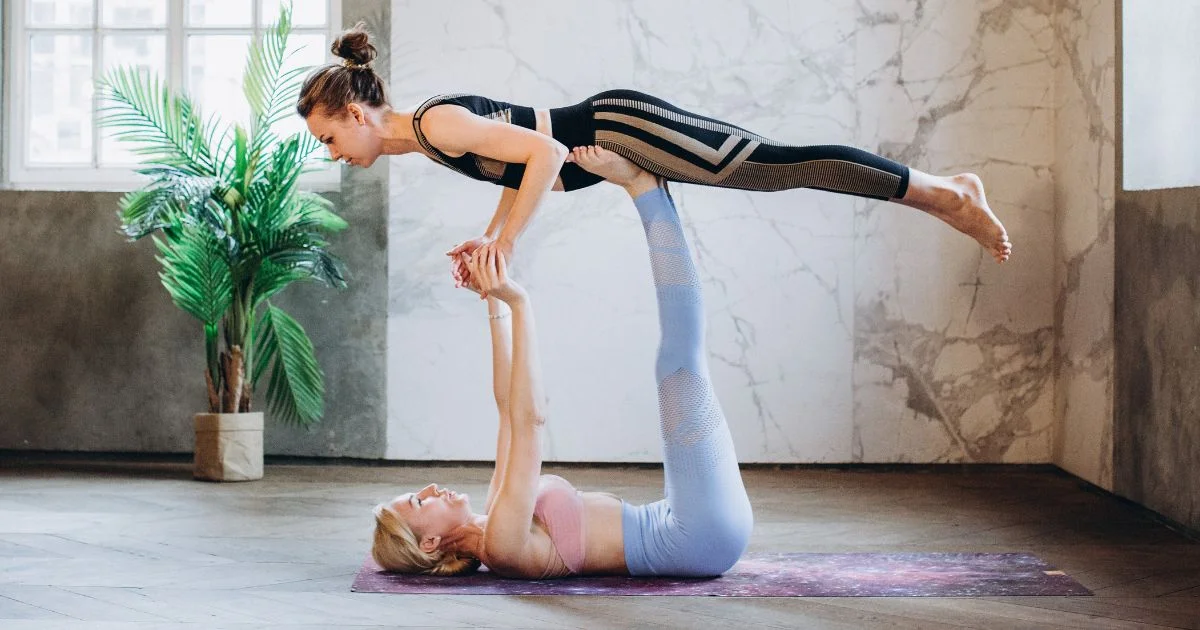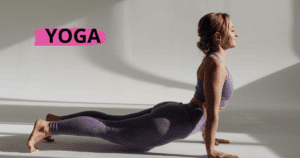Acro Yoga for Beginners:
Embrace the Fusion of Yoga and Acrobatics
Acro yoga is an exhilarating practice that combines elements of yoga, acrobatics, and Thai massage. It is a dynamic and playful discipline that promotes teamwork, communication, and connection between partners. Acro yoga for beginners offers an exciting opportunity to dive into this fusion of balance, strength, and trust while discovering the joy of shared movement.
In this comprehensive guide, we will explore the world of acro yoga for beginners, providing you with valuable insights, step-by-step instructions, and essential safety precautions. Whether you’re a seasoned yogi or completely new to both yoga and acrobatics, this article will serve as a trusted resource to start your acro yoga journey.
 Acro Yoga for Beginners: Laying the Foundation
Acro Yoga for Beginners: Laying the Foundation
In this section, we’ll lay the groundwork for your acro yoga practice, starting with an understanding of the basic principles and benefits.
What is Acro Yoga?
Acro yoga is a fusion of acrobatics, yoga, and healing arts, performed in pairs or groups. It combines the mindfulness of yoga with the strength and balance of acrobatics, creating a harmonious and exhilarating experience.
You may also like..BFF 2 Person Yoga Poses: Strengthening Bonds and Bodies Together Bikram Yoga Postures: A Comprehensive Guide to 26 postures What are 10 Benefits of Doing Yoga Everyday?10 Effective Benefits
The Three Roles in Acro Yoga
- Base: The person who supports the flyer by maintaining a strong and stable foundation. They are usually in contact with the ground.
- Flyer: The person who is elevated off the ground by the base, often engaging in various poses that require balance and flexibility.
- Spotter: The individual responsible for ensuring the safety of the base and flyer, ready to assist if necessary.
Benefits of Acro Yoga for Beginners
- Strength Building: Acro yoga requires engagement of various muscle groups, helping beginners develop strength and tone their bodies.
- Improved Flexibility: Regular practice enhances flexibility, making complex poses more accessible over time.
- Trust and Communication: Acro yoga fosters trust and communication between partners, strengthening their connection.
- Mindfulness and Relaxation: It combines breathwork and mindfulness techniques, promoting relaxation and stress relief.
Preparing for Your Acro Yoga Practice
Before diving into your first acro yoga session, it’s crucial to take some essential steps to ensure a safe and enjoyable experience.
Choosing the Right Partner
Finding the right partner is essential for a successful acro yoga practice. Look for someone who communicates effectively, shares your goals, and respects safety protocols.
Selecting the Ideal Location
Practice acro yoga in a spacious, well-padded area free of sharp objects or obstacles. Grass or a padded gym floor are great choices for beginners.
Warming Up and Cooling Down
Start with a gentle warm-up that includes stretches for the shoulders, hips, and hamstrings. After your practice, take time to cool down and stretch to prevent soreness.
Using Spotters
For beginners, having a spotter is highly recommended. Spotters provide an extra layer of safety and can assist in finding balance during challenging poses.
Essential Acro Yoga Poses for Beginners
Now that you’re prepared, let’s explore some foundational acro yoga poses for beginners that will build your confidence and teamwork.
1. Folded Leaf
Base: Sit with your legs extended and slightly apart. The flyer stands facing away and bends forward, placing their feet on the base’s thighs. The base holds the flyer’s hands for support.
Flyer: Bend forward and place your feet on the base’s thighs, extending your arms forward for balance.
Benefits: This pose enhances balance, stretches the hamstrings, and promotes trust between partners.
2. Throne Pose
Base: Sit with your knees bent, feet flat on the ground, and lean back slightly. The flyer stands in front, facing the base, and places their feet on the base’s thighs.
Flyer: Step onto the base’s thighs and hold their hands for support. Engage your core for stability.
Benefits: Throne pose strengthens the core, improves balance, and allows for easy communication between partners.
3. Star Pose
Base: Lie on your back with your knees bent and feet flat on the ground. The flyer stands facing away and places their feet on the base’s hands.
Flyer: Step onto the base’s hands and extend your arms and legs wide, forming a star shape.
Benefits: Star pose improves coordination, strengthens the arms and legs, and encourages teamwork.
4. Supported Backbend
Base: Sit with your legs extended and slightly apart. The flyer stands in front, facing the base, and bends backward, placing their hands on the base’s knees for support.
Flyer: Carefully arch backward, placing your hands on the base’s knees and extending your spine.
Benefits: Supported backbends increase spine flexibility and open the chest, promoting trust and communication.
Safety Tips for Acro Yoga Beginners
Acro yoga is a thrilling practice, but safety must always be a top priority. Follow these safety tips to ensure a secure and enjoyable experience.
1. Start Low and Slow
Begin practicing close to the ground and progress gradually as you gain confidence and strength.
2. Use Spotters
Spotters provide crucial support, especially when attempting new or challenging poses.
3. Communicate Clearly
Maintain open communication with your partner throughout the practice to prevent accidents and misunderstandings.
4. Respect Your Limits
Don’t push yourself or your partner beyond your abilities. Respect your body’s limitations and take breaks when needed.
5. Stay Hydrated
Drink plenty of water before and after your acro yoga session to stay hydrated and maintain optimal performance.
Conclusion: Embrace the Journey of Acro Yoga
Acro yoga for beginners is an exciting and transformative practice that encourages physical strength, mental focus, and deep connections with others. By following the fundamental principles, essential poses, and safety tips outlined in this article, you can confidently embark on your acro yoga journey.
Remember always to prioritize safety, communication, and mutual trust with your partner. As you progress and build a solid foundation, the fusion of yoga and acrobatics will empower you to achieve balance, joy, and mindfulness.
So, take a leap of faith, find your acro yoga partner, and embark on this delightful adventure together!
Disclaimer:The information provided in this article about “Acro Yoga for Beginners” is for general informational purposes only and should not be considered as professional advice. Readers are encouraged to consult with qualified yoga instructors or healthcare professionals for personalized guidance and safety precautions.
FAQs
Is Acro Yoga Safe for Beginners?
Yes, acro yoga is generally safe for beginners when practiced with proper guidance and safety measures in place.
Do I Need to Be Flexible to Start Acro Yoga?
No, acro yoga can help improve flexibility over time, and many poses can be modified for different skill levels.
Can I Practice Acro Yoga Alone?
While some yoga poses can be practiced alone, acro yoga requires a partner for support and balance.
What if I'm Afraid of Heights?
Acro yoga poses are generally close to the ground, but communicate your fear with your partner, and start with low poses until you feel comfortable.
Is Acro Yoga a Good Workout?
Yes, acro yoga engages various muscle groups, providing an excellent full-body workout.
How Long Does It Take to Learn Acro Yoga Poses?
The time to learn acro yoga poses varies from person to person. With regular practice and dedication, you can progress steadily.




